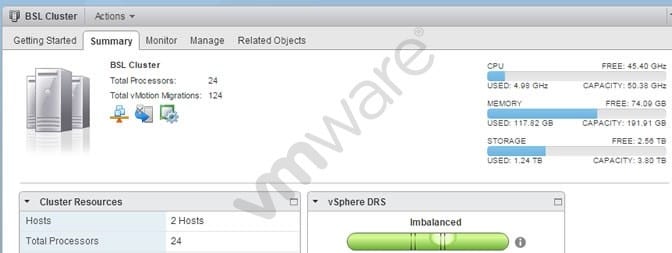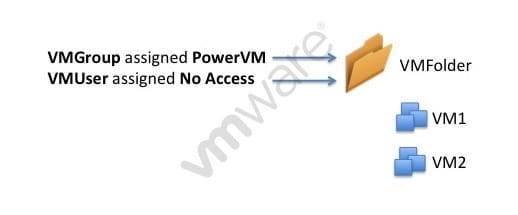Exam Details
Exam Code
:2V0-621DExam Name
:VMware Certified Professional 6 – Data Center Virtualization Delta BetaCertification
:VCP6-DCVVendor
:VMwareTotal Questions
:245 Q&AsLast Updated
:May 06, 2025
VMware VCP6-DCV 2V0-621D Questions & Answers
-
Question 111:
When attempting to remove a host from a vSphere Distributed Switch (vDS), an administrator observes the error message:
The resource `16' is in use
What are two reasons why this error would be displayed? (Choose two.)
A. Vmkernel network adapters on the vDS are in use.
B. Virtual machine network adapters are connected to the vDS.
C. Network I/O Control has been configured on the vDS.
D. There is active network traffic on the vDS.
-
Question 112:
An administrator is unable to upgrade a vCenter Server Appliance from version 5.1 Update 2 to version 6.0. What is a likely reason for this?
A. vCenter Server Appliance 6.0 does not support upgrades from version 5.1 Update 2.
B. vCenter Server Appliance must be joined to an Active Directory domain before upgrading to version 6.0.
C. vCenter Server Appliance 5.1 Update 2 uses an incompatible database for upgrading to version 6.0.
D. vCenter Server Appliance 6.0 must be upgraded using the vSphere Web Client.
-
Question 113:
A failed upgrade from vCenter Server version 5.x to version 6.0 produces the following error: [00800 error `Default'] Database version id `600' is incompatible with this release of VirtualCenter. What is the cause of the upgrade failure?
A. There was a database schema upgrade failure during the installation.
B. The VMWAREVCMSDS service was upgraded before the vCenter Server service.
C. The Vmware Directory Service database failed during the installation.
D. There was an incompatible ODBC driver version for the database.
-
Question 114:
A task fails while creating a VMFS5 datastore on a disk with these characteristics:
Was previously used by a Linux server Was not erased Is visible with the vSphere Web Client
Which action can be performed to resolve the issue?
A. Delete the partitions on the disk manually with partedUtil first.
B. Create a VMFS3 file system first, then upgrade it.
C. Create the VMFS5 file system manually using vmkfstools.
D. Delete the data with the vmkfstools command.
-
Question 115:
An administrator is attempting to enable Legacy Fault Tolerance (FT) on a virtual machine and observes the following in the vSphere Web Client: Fault Tolerance has not been licensed on host
. What is the minimum licensed edition that supports this configuration? A. Standard
B. Enterprise
C. Enterprise Plus
D. Essentials Plus
-
Question 116:
A user notifies an administrator that Content Libraries are not visible. What is a possible solution?
A. Assign the user the read-only role at the global permission level.
B. Assign the user the read-only role at the vCenter Server root level.
C. Assign the user the read-only role at the vCenter Server data center level.
D. Assign the user the read-only role at the vCenter Server cluster level.
-
Question 117:
Refer to the Exhibit.

An administrator is reviewing a vSphere Distributed Resource Scheduler (DRS) enabled Cluster and observes unexpected behavior as shown in the Exhibit. What are three potential causes of the cluster imbalance? (Choose three.)
A. A local device is mounted to one or more virtual machines.
B. DRS rules prevent virtual machines from being moved.
C. vMotion is not configured and enabled.
D. There are insufficient cluster resources to perform the migration.
E. DRS has been configured for a conservative migration threshold.
-
Question 118:
Refer to the Exhibit.

An administrator receives the error message shown in the Exhibit. Which two actions can be taken to clear the warning? (Choose two.)
A. Add a Virtual SAN datastore and configure it for High Availability heartbeating.
B. Set the advanced High Availability parameter Das.heartbeatdsperhost to 1.
C. Set the advanced High Availability parameter Das.ignoreInsufficientHbDatastore to true.
D. Add a shared datastore and reconfigure High Availability.
-
Question 119:
An administrator is troubleshooting a CPU issue for a virtual machine. The following is seen in esxtop:
CPU0 is at 100% usage
The remaining logical CPUs are close to 0%
%RDY value is consistently above 10%
What is likely the cause of the CPU issue?
A. The virtual machine has a CPU limit configured.
B. The virtual machine's guest operating system is configured for SMP.
C. The virtual machine has CPU affinity configured.
D. The virtual machine is configured with a CPU reservation.
-
Question 120:
Refer to the Exhibit.

Review the Exhibit. An administrator has configured permissions for a group called VMGroup and a user named VMUser. A new Role has been created called PowerVM. The group and role have these charecteristics:
PowerVM role can power on VMs VMGroup granted PowerVM role on VMFolder VMUser is a member of VMGroup VMUser granted No Access on VMFolder
Based on the exhibit, which statement best explains why VMUser is denied access to the VMFolder?
A. The VMUser permission overrides the VMGroup permission.
B. The No Access role overrides the PowerVM role.
C. The VMGroup permission overrides the VMUser permission.
D. The PowerVM role overrides the No Access role.
Related Exams:
Tips on How to Prepare for the Exams
Nowadays, the certification exams become more and more important and required by more and more enterprises when applying for a job. But how to prepare for the exam effectively? How to prepare for the exam in a short time with less efforts? How to get a ideal result and how to find the most reliable resources? Here on Vcedump.com, you will find all the answers. Vcedump.com provide not only VMware exam questions, answers and explanations but also complete assistance on your exam preparation and certification application. If you are confused on your 2V0-621D exam preparations and VMware certification application, do not hesitate to visit our Vcedump.com to find your solutions here.